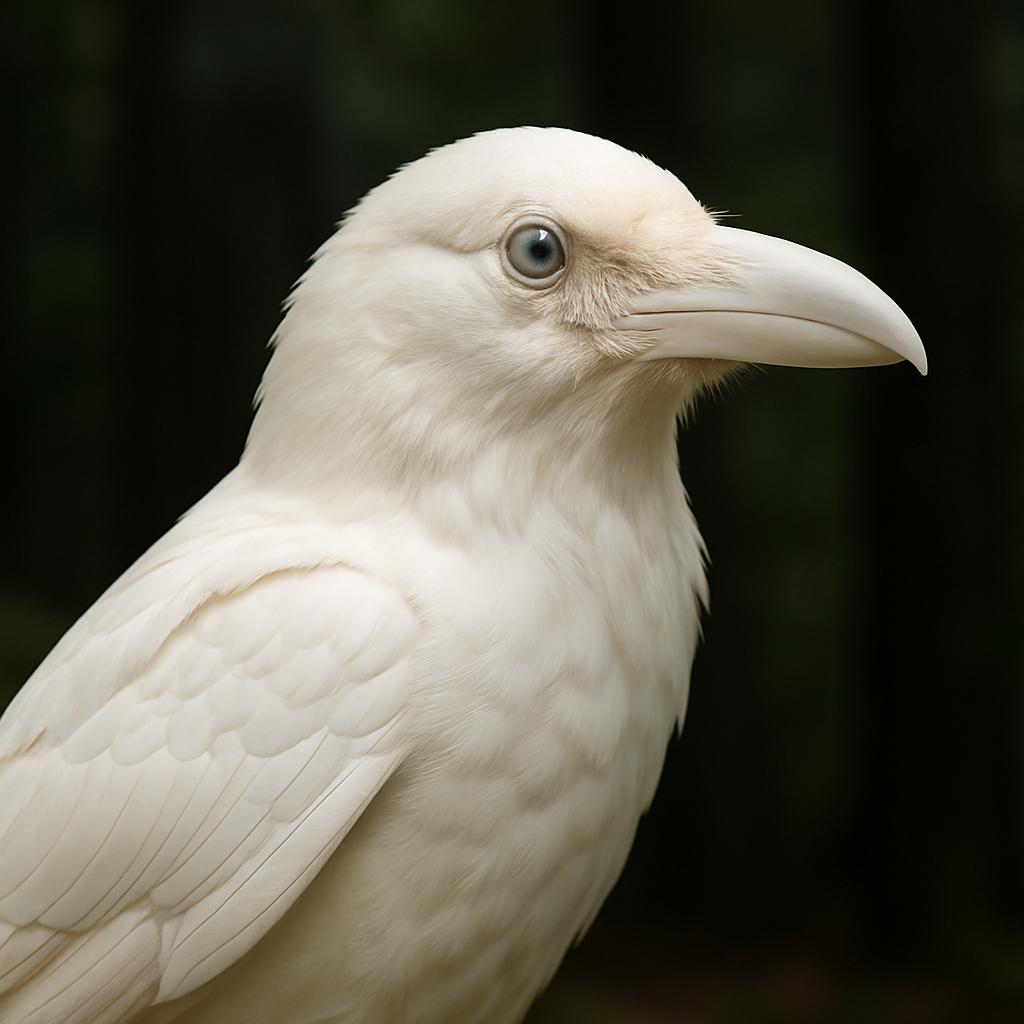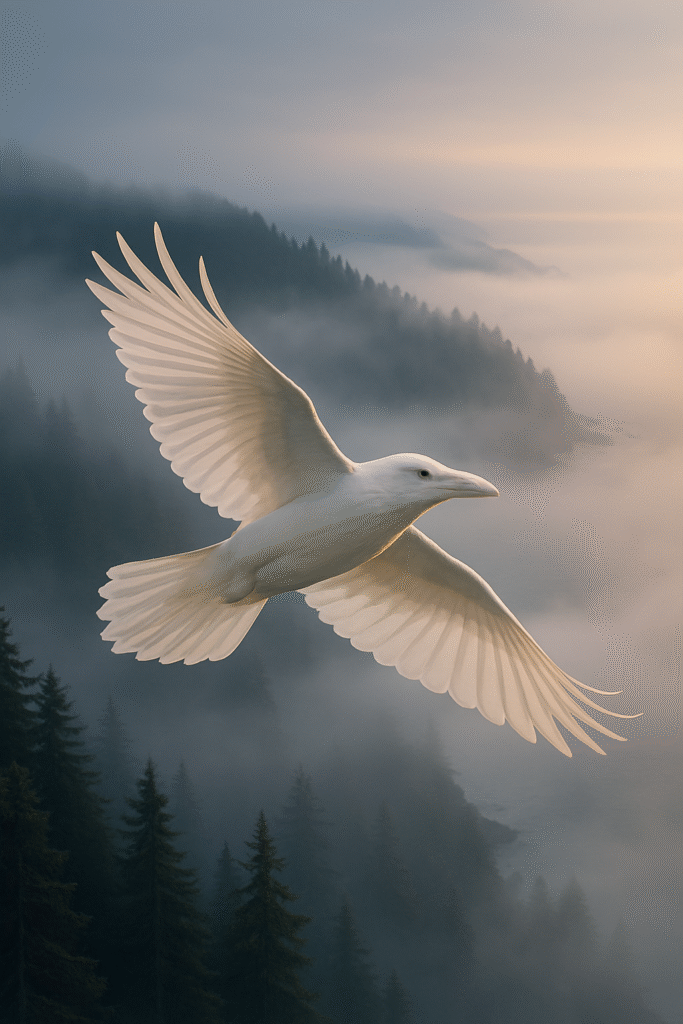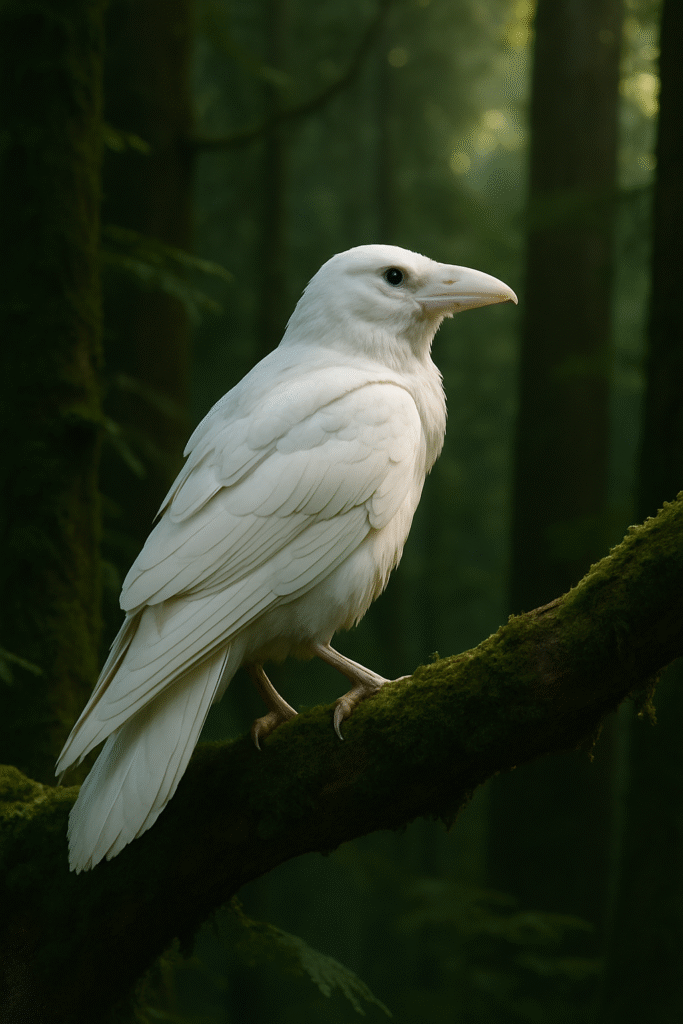Introduction – When Shadows Turn White
To glimpse a raven is nothing unusual. They are among the most widespread and intelligent birds on Earth, their black wings beating across forests, cities, and mountains alike. But on rare occasions, the familiar silhouette transforms into something otherworldly — a White Raven, pale as snow, glowing against the dark canvas of the world. For many, such a sight feels less like an animal encounter and more like an intrusion of myth into the ordinary. The White Raven is not just a bird; it is a rare encounter that unites biology, folklore, and the human hunger for symbols.

The Science of Rarity – Why White Ravens Exist
Ordinary ravens (Corvus corax) wear their midnight plumage thanks to melanin, the pigment that also strengthens their feathers. The White Raven, however, owes its ghostly appearance to a genetic mutation known as leucism. Unlike albinism, leucism allows for traces of pigment in the eyes and skin, but it strips the feathers of their natural darkness.
Leucism is extremely rare in ravens, which makes each sighting newsworthy. Most reports come from Vancouver Island, British Columbia, where a small population has carried this genetic trait for decades. Generations of birdwatchers, hikers, and Indigenous peoples have passed down stories of the pale birds, treating them as symbols of mystery and change.
SEO Focus Words: white raven, rare raven sighting, leucistic raven, rare bird encounter, genetic mutation in birds.
Ravens in Myth – Tricksters and Messengers
To understand why the White Raven holds such power over the imagination, one must first recall the place of the raven in world mythology.
- Norse Mythology – Odin, the All-Father, was flanked by two ravens, Huginn (thought) and Muninn (memory), who circled the world to bring him knowledge. Their black wings were synonymous with mystery, cunning, and the bridging of worlds.
- Indigenous Pacific Northwest Mythology – The raven is a creator, a trickster, and a bringer of light. Some Haida stories tell of a white raven who brought daylight to the world but turned black when it flew too close to the smoke of creation.
- European Folklore – Ravens were omens of war and prophecy, their presence believed to foretell death or change.
Against this backdrop, the White Raven appears as a reversal — not an omen of death, but of transformation and renewal. Where black ravens whisper of endings, the White Raven seems to whisper of beginnings.
SEO Focus Words: white raven mythology, symbolism of white raven, raven folklore, white raven spiritual meaning.
Rare Encounters – From the Forest to the Camera Lens
The most famous White Ravens live on Vancouver Island, where sightings have inspired photographers and birders alike. Their pale wings stand in stark contrast to the evergreen forests and gray ocean skies of the Pacific Northwest. Some scientists believe the limited island population allows the leucistic gene to recur more frequently, producing multiple White Ravens across decades.

Each sighting is met with awe. Photos of these birds go viral across social media, headlines proclaim “Ghost Raven Spotted Again,” and locals speak of them in hushed tones. For many, the appearance of a White Raven is more than a biological oddity — it is a personal omen, a sign of luck, change, or destiny.
SEO Focus Words: rare raven sighting, white raven Vancouver Island, rare animal encounter, leucistic raven photography.
The Symbolism of the White Raven – Shadow and Light
If the black raven represents darkness, secrecy, and the unknown, then the White Raven represents illumination of the hidden. It becomes a metaphor for truth emerging from shadows, for rare clarity in a world of confusion.
In psychological symbolism, the White Raven is often interpreted as:
- Transformation – a shift in perspective or destiny.
- Balance – the union of opposites (light and dark, life and death, seen and unseen).
- Mystery Made Visible – proof that even the rarest, most improbable realities can emerge before our eyes.
This duality makes the White Raven a profoundly spiritual symbol. In literature and philosophy, it embodies the rare moment when the extraordinary pierces the ordinary, when we are reminded that the world is stranger, richer, and more alive than we believe.
SEO Focus Words: symbolic meaning of white raven, white raven omen, rare spiritual animals, white raven encounter meaning.
The Human Psyche – Why We Seek Rarity
What makes a White Raven so captivating is not only its appearance but the psychology of rarity itself. Humans are drawn to what is elusive — from gemstones hidden in mountains to whispered legends of hidden beasts. In ecology, rarity means fragility; in the human mind, rarity means value, sacredness, and story.
A White Raven sighting becomes a personal myth. It lingers not because the bird is pale, but because the encounter makes us pause, reflect, and reconsider the mystery of the natural world.
SEO Focus Words: rare wildlife encounter, why rare animals matter, human fascination with rare animals, symbolic rare bird.
Closing Reflection – The Ghost in the Canopy
Imagine standing at the edge of a coastal forest at dusk. Shadows stretch long across the mossy ground, and the air hums with the sound of unseen wings. Then, out of the gloom, a flash of pale feathers cuts across the treetops. For a heartbeat, the White Raven is there — ancient and newborn, spectral yet real. And then, as quickly as it appeared, it is gone.

Such is the nature of a rare encounter: it is not meant to be held, only witnessed. The White Raven reminds us that rarity is not absence — it is presence on its own terms, brief but eternal in memory.
SEO Focus Words: white raven sighting, rare encounter with white raven, meaning of white raven in nature.


Reply